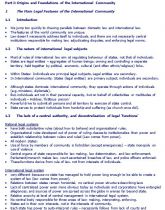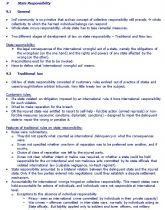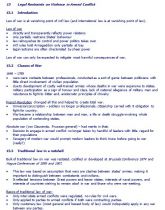Hledej
Zobraz:
Univerzity
Kategorie
Rozšířené vyhledávání
12 662
projektů
Antonio Cassese - International Law
| Přípona .doc |
Typ studijní materiál |
Stažené 0 x |
| Velikost 0,5 MB |
Jazyk anglický |
ID projektu 9371 |
| Poslední úprava 09.01.2017 |
Zobrazeno 1 425 x |
Autor: clean.bandit |
 Sdílej na Facebooku
Sdílej na Facebooku |
||
| Detaily projektu | ||
- Cena:
4 Kreditů - kvalita:
90,0% -
Stáhni
- Přidej na srovnání
- Univerzita:Univerzita Karlova v Praze
- Fakulta:Fakulta sociálních věd
- Kategorie:Humanitní vědy » Právo
- Předmět:Mezinárodní právo
- Studijní obor:-
- Ročník:3. ročník
- Formát:MS Office Word (.doc)
- Rozsah A4:92 stran
Part I: Origins and Foundations of the International Community
1 The Main Legal Features of the International Community
1.1 Introduction
• We jump too quickly to drawing parallels between domestic law and international law.
• The features of the world community are unique.
• Law doesn’t necessarily address itself to individuals, and there are not necessarily central institutions responsible for making law, adjudicating disputes, and enforcing legal norms.
1.2 The nature of international legal subjects
• Most of rules of international law aim at regulating behaviour of states, not that of individuals.
• States are legal entities - aggregates of human beings, owning and controlling a separate territory, held together by political, economic, cultural (and often ethnic/religious) links.
• Within States: Individuals are principal legal subjects, Legal entities are secondary.
• In International community: States (legal entities) are primary subject, individuals are secondary.
• Although states dominate international community, they operate through actions of individuals (e.g. ministers, diplomats).
• But, individuals act not in their personal capacity, but on behalf of collectivities or multitudes of individuals - Hobbes, ‘fictitious person’
• Powerful drive to submit all persons and all territory to exercise of state control.
• State serves to protect individuals from hardship and suffering (as church once did).
1.3 The lack of a central authority, and decentralisation of legal ‘functions’
National legal systems
• have both substantive rules (about how to behave) and organisational rules.
• Organisational rules developed out of power of ruling classes to institutionalise their power and establish relationship between rulers and ruled (Law comes from power).
• All modern states:
• Use of force by members of community is forbidden (except emergencies) - state monopoly on use of violence
• Central organs of state responsible for law making, law determination, and law enforcement. Parliament/monarch makes law, court ascertained breaches of law, and police officers enforced.
• These functions derive from rule of law, not from interests of individuals.
1 The Main Legal Features of the International Community
1.1 Introduction
• We jump too quickly to drawing parallels between domestic law and international law.
• The features of the world community are unique.
• Law doesn’t necessarily address itself to individuals, and there are not necessarily central institutions responsible for making law, adjudicating disputes, and enforcing legal norms.
1.2 The nature of international legal subjects
• Most of rules of international law aim at regulating behaviour of states, not that of individuals.
• States are legal entities - aggregates of human beings, owning and controlling a separate territory, held together by political, economic, cultural (and often ethnic/religious) links.
• Within States: Individuals are principal legal subjects, Legal entities are secondary.
• In International community: States (legal entities) are primary subject, individuals are secondary.
• Although states dominate international community, they operate through actions of individuals (e.g. ministers, diplomats).
• But, individuals act not in their personal capacity, but on behalf of collectivities or multitudes of individuals - Hobbes, ‘fictitious person’
• Powerful drive to submit all persons and all territory to exercise of state control.
• State serves to protect individuals from hardship and suffering (as church once did).
1.3 The lack of a central authority, and decentralisation of legal ‘functions’
National legal systems
• have both substantive rules (about how to behave) and organisational rules.
• Organisational rules developed out of power of ruling classes to institutionalise their power and establish relationship between rulers and ruled (Law comes from power).
• All modern states:
• Use of force by members of community is forbidden (except emergencies) - state monopoly on use of violence
• Central organs of state responsible for law making, law determination, and law enforcement. Parliament/monarch makes law, court ascertained breaches of law, and police officers enforced.
• These functions derive from rule of law, not from interests of individuals.
Klíčová slova:
legal features
international community
enforcement
responsibility
contemporary issue
Obsah:
- Part I: Origins and Foundations of the International Community 3
1 The Main Legal Features of the International Community 3
1.1 Introduction 3
1.2 The nature of international legal subjects 3
1.3 The lack of a central authority, and decentralisation of legal ‘functions’ 3
1.4 Collective responsibility 4
1.5 The need for most international rules to be translated into national legislation 4
1.6 The range of States’ freedom of action 4
1.7 The overriding role of effectiveness 5
1.8 Traditional individualistic trends and emerging obligations and rights 5
1.9 Coexistence of the old and new patterns 6
2 The historical evolution of the international community 8
2.1 Introduction 8
3 States as the primary subjects of international law 9
3.1 Traditional and New Subjects 9
3.2 Commencement of the Existence of States 9
3.3 The Role of Recognition 9
3.4 Continuity and Termination of Existence of States 10
3.5 Spatial Dimensions of State Activities 11
3.6 The Legal Regulation of Space, Between Sovereignty and Community Interests 16
4 Other International Legal Subjects 17
4.1 Insurgents 17
4.2 The reasons behind the emergence of new international subjects 18
4.3 International organizations 18
4.4 National liberation movements 20
4.5 Individuals 21
5 The fundamental principles governing international relations 24
5.1 Introduction 24
5.2 The sovereign equality of States 24
5.3 Immunity and other limitations on sovereignty 25
5.4 Non-intervention in the internal or external affairs of other States 28
Part II: Creation and Enforcement of International Legal Standards 30
6 International law-making: Customs and Treaties 30
6.1 Introductory remarks 30
6.2 Custom 31
6.3 Treaties 33
6.4 Codification 38
6.5 The introduction of jus cogens in the 1960s 38
8 Implementation of international rules within national systems 42
8.1 Relationship between international and national law 42
8.2 International rules on implementing international law in domestic legal systems 43
8.3 Trends emerging among the legal system of States 44
8.4 Techniques of implementation 46
8.5 Statist versus international outlook: emerging trends 48
9 State Responsibility 50
9.1 General 50
9.2 Traditional law 50
9.3 The current regulation of State responsibility: an overview 51
9.4 ‘Ordinary’ State responsibility 52
9.5 ‘Aggravated’ State responsibility 57
9.6 The special regime of responsibility in case of contravention of community obligations provided for in multilateral treaties 60
9.7 The current minor role of aggravated responsibility 62
10 Mechanisms for promoting compliance with international rules and pursuing the prevention or peaceful settlement of disputes 63
10.1 Introduction 63
10.2 Traditional mechanisms for promoting agreement 63
10.3 Traditional mechanisms for settling disputes by a binding decision 64
10.4 The new law: an overview 64
10.5 The general obligation to settle disputes peacefully 65
10.6 Resort to traditional means 65
10.7 Strengthening and institutionalizing of traditional means 66
10.8 The establishment of more flexible mechanisms for either preventing or settling disputes 68
Part III: Contemporary Issues in International Law 70
14 Collective Security and the Prohibition of Force 70
14.1 Maintenance of Peace and Security by Central Organs or with their Authorization 70
14.2 Peacekeeping Operations 71
14.3 Collective Measures not Involving the Use of Force 72
14.4 Exceptionally Permitted Resort to Force by States 74
14.5 Use of force when self-determination is denied 80
14.6 The old and the new law contrasted 80
15 Legal Restraints on Violence in Armed Conflict 82
15.1 Introduction 82
15.2 Classes of War 82
15.3 Traditional law in a nutshell 82
15.4 New developments in modern armed conflict 83
15.5 The new law: an overview 83
15.6 Current regulation of international armed conflict 84
15.7 Current regulation of internal armed conflict 90
15.8 The role of law in restraining armed violence 92


